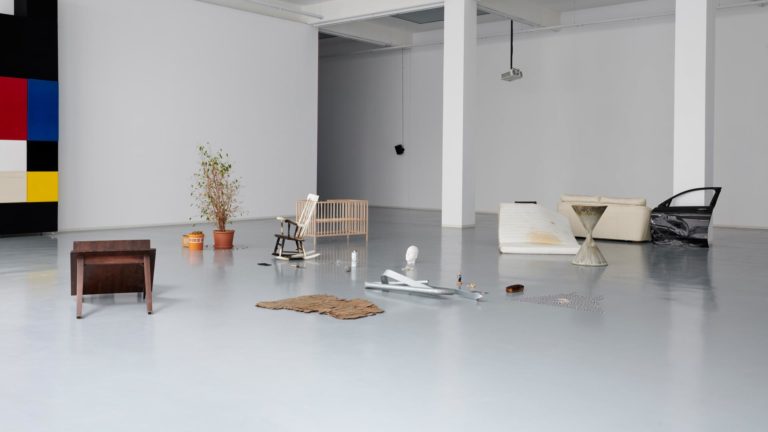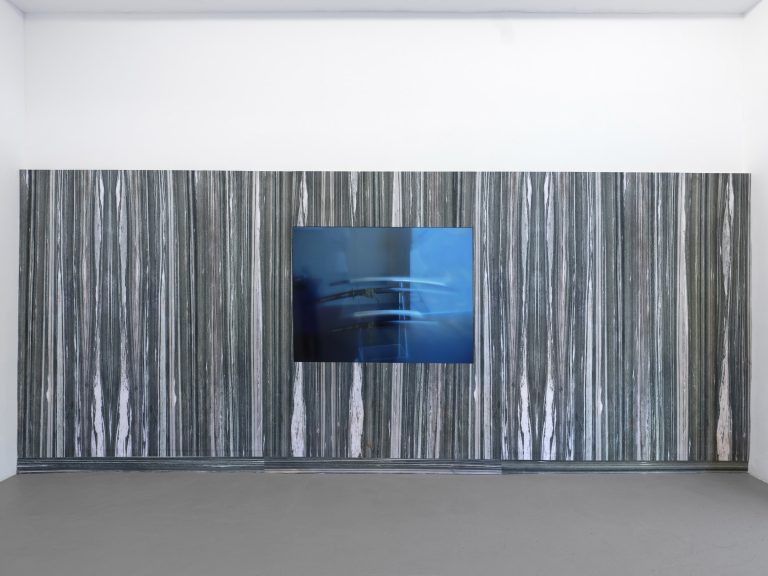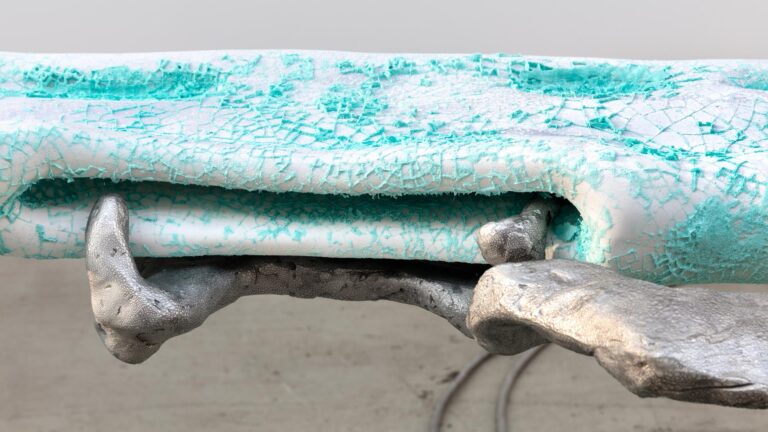Artist: Johannes Tassilo Walter
Exhibition title: Weigert Sinn
Venue: Nir Altman, Munich, Germany
Date: September 8 – October 13, 2018
Photography: all images copyright and courtesy of the artist and Nir Altman, Munich
The painter talks only unwillingly about what he is doing. That is a cliché, and yet it is no shortcoming—his works are a carrier of meaningful processes. Black ink is being applied with a broad brush on paper and again washed away, whereby substantial parts of the shiny paint layer drains off the sink. Only those paint residues remain as painterly gestures on the paper due to the water pressure or drying.
It is about marking and painting over, hiding and showing. The work within the studio is central to Walter. The merely handling with spanned paper in these dimensions and with water requires a lot material-related knowledge and experience. Also, the repeated painterly gesture in all works is apparently no eruptive outbreak but a result of an intensive study. Walter calls them “dog”. A simple shape which he has extracted from his form vocabulary and which he deliberately has chosen as a carrier for the signum “painterly gesture”. In the “dog”, coincidence and repetition are in a balanced relation. At the same time a “dog” or only “half a dog” can mark henceforth areas of the paper, where this relinquishes its tensed flatness. It presents itself as soft and true storage of even minimum painterly occurrences. If you want, you can discover in the ramifications of the ink fantastic landscapes as for instance to find in polished stone surfaces. In the time of curiosity cabinets those stones appeared as artworks of a super-personal creating natura pictrix which should nourish the imagination of its owners.
Walter’s method is not only a result of continuous research of the graphics means under self-imposed, narrow limits. Possibly, his practice also points to a worldliness phobically cast aside by the abstraction of his works—in the spirit of analysis this worldliness has paved its way there where you could control it least. The painterly gesture and its trace on the surface as well as the characteristics of the material and its origin and history of usage give enough clues for the delineation of an oeuvre which ignores its creator nonchalant at this point. Thereby, you could stop—but then you wouldn’t bank on Walter, who has chosen two different ways through the back door to position himself in the paintings as their creator. The first way leads from the studio into the gallery rooms and concerns the arrangement of the paintings and sheets in space. Walter carefully reacts to the spatial specifications and uses what was formerly an autonomous image as a decorative spatial element with a subtle potential for interference. So, his biggest upright format is overlapping the defined hanging space, it edges over the end of the mounted wall and accepts gladly with all its lightness an imbalance in the room. The gallery space is being used after the principles of an art which knows how to adjust parasitically to its environment. More surprising as the calculated, spatial settlement is the second intrusion of the artist.
Thereby, the ambiguity of his works is being thwarted with the means of parody. Three exhibition posters in the entrance area cite a construct which is occupied with strong ideologies. They are showing the artist in the creation process within his studio. This theme is expressed in three poses which show the scantily clad artist working in front of the canvas. The title „Weigert Sinn” is placed in the image surface of all three motives inserting itself smoothly into the narrative of the artist-subject which is moved by inner vigour. Thereby, the artist performs what the inner necessity demands, without accounting for himself or others towards his conduct. And yet a white fine rib pants mark very obviously the spot in which Kippenbergian irony trickles into the image and the artistic myth is being unmasked. By changing from pathos to parody and by taking himself for a ride with a winking Walter shakes off the ideological burden of the grand gesture and satirizes this. The decision whether this approach affects or even increases the formal integrity of the exhibited works leaves the artist thereby very nonchalant to us the spectators.
Text by Tina Schulz (2018), translated by Franziska Wilmsen
Johannes Tassilo Walter, Weigert Sinn, 2018, exhibition view, Nir Altman, Munich
Johannes Tassilo Walter, Weigert Sinn, 2018, exhibition view, Nir Altman, Munich
Johannes Tassilo Walter, Weigert Sinn, 2018, exhibition view, Nir Altman, Munich
Johannes Tassilo Walter, Weigert Sinn, 2018, exhibition view, Nir Altman, Munich
Johannes Tassilo Walter, Weigert Sinn, 2018, exhibition view, Nir Altman, Munich
Johannes Tassilo Walter, O.T. (DOG 1), 2018
Johannes Tassilo Walter, O.T. (DOG 2), 2018
Johannes Tassilo Walter, O.T. (DOG 3), 2018
Johannes Tassilo Walter, O.T. (DOG 4), 2018
Johannes Tassilo Walter, O.T. (DOG 5), 2018
Johannes Tassilo Walter, O.T. (DOG ERASED), 2018
Johannes Tassilo Walter, O.T. (SHOWER), 2018
Johannes Tassilo Walter, Weigert Sinn, 2018, exhibition view, Nir Altman, Munich
Johannes Tassilo Walter, O.T. (THE WHITE ONE), 2018
Johannes Tassilo Walter, O.T. (WINONAH), 2018
Johannes Tassilo Walter, WEIGERT SINN, 2018






















